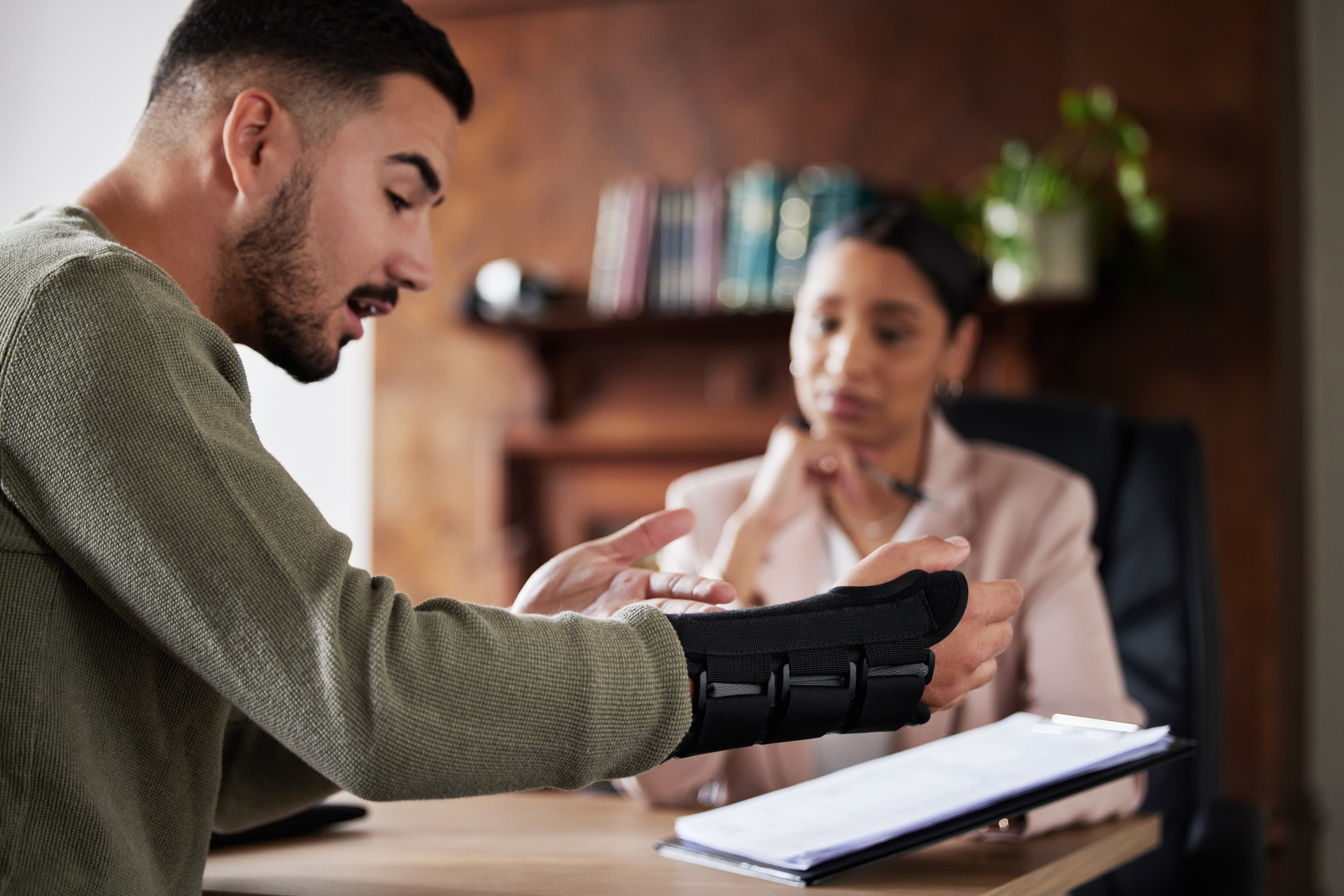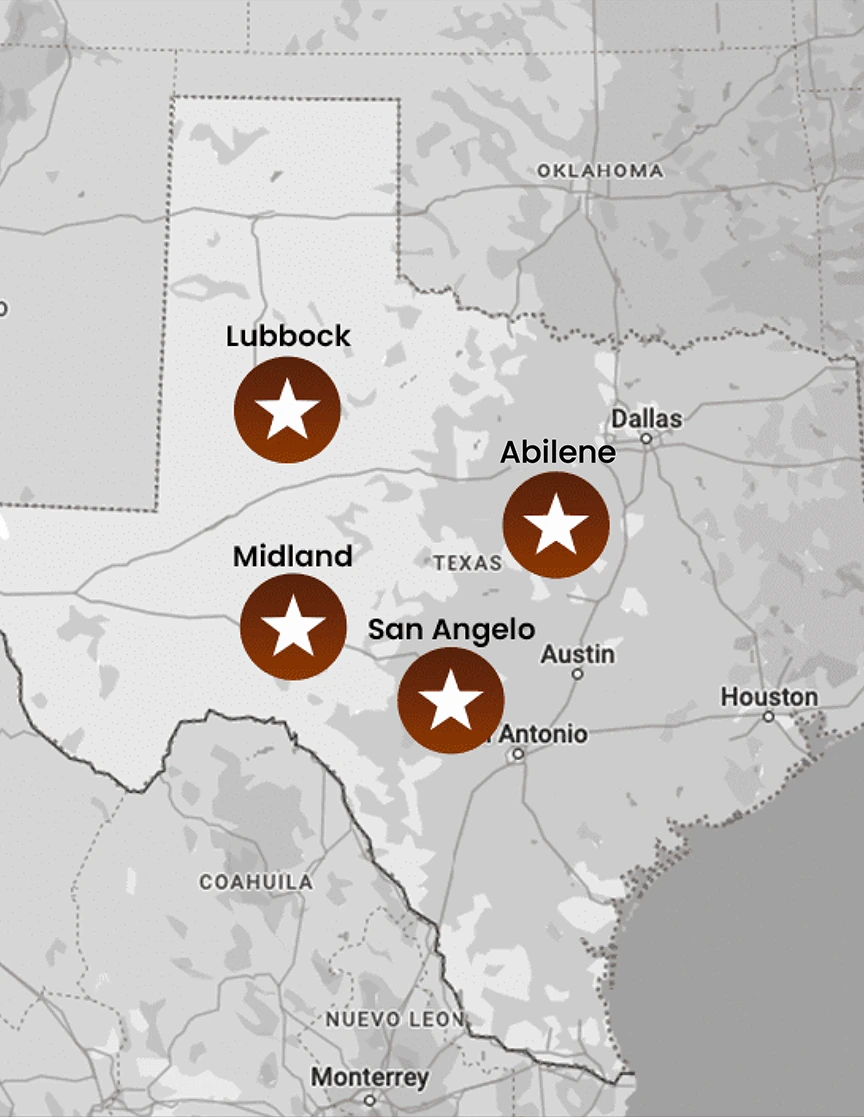Arm pain is a common but often overlooked symptom after a car accident. Whether it’s a minor strain or a sign of a serious underlying injury, such as nerve damage or a fracture, ignoring arm pain can lead to long-term complications.
The force of a collision can cause sprains, muscle tears, or even broken bones, making immediate medical evaluation essential. In Texas, personal injury laws allow accident victims to seek compensation for medical expenses, lost wages, and pain and suffering.
However, insurance companies often downplay injuries or offer low settlements, especially when symptoms take time to develop. That’s why having our experienced legal team on your side is best.
At Keith & Lorfing, we bring over 100 years of combined experience, 500 jury trials, and a reputation as Abilene’s Best Lawyers of 2023 to every case. We know what it takes to fight for West Texans and ensure you receive the full compensation you deserve.

Contact our Lubbock car accident lawyers today for a free consultation and let us help you understand your rights and fight for the compensation you deserve.
What Causes Arm Pain After a Car Accident?
Arm pain after a car crash can result from direct impact, sudden movements, or nerve damage. Knowing the common types of arm injuries can help you identify symptoms and seek the right medical and legal assistance.
- Impact Injuries: Hitting the dashboard, steering wheel, or airbag can cause contusions, fractures, and ligament tears, leading to severe pain and swelling.
- Whiplash-Related Injuries: Whiplash doesn’t just affect the neck—it can cause pain in the upper arm, shoulders, and hands due to strained muscles and tendons that stabilize the shoulder.
- Bracing for Impact: Many drivers instinctively grip the steering wheel tightly before a crash, resulting in sprains, rotator cuff injuries, and muscle tears.
- Fractures & Breaks: High-impact crashes can fracture the humerus, radius, ulna, or clavicle, causing intense pain, swelling, and limited range of motion. Treatment may include splints, immobilization, or surgery.
- Soft Tissue Injuries: Overstretched muscles, tendons, or ligaments can lead to rotator cuff tears, sprains, and chronic pain. Physical therapy may be required for recovery.
- Joint Dislocations: The shoulder and elbow joints can dislocate due to the force of a crash, leading to severe pain, swelling, and mobility issues.
- Nerve Damage: A brachial plexus injury occurs when nerves running from the spinal cord to the arm are compressed or stretched, causing numbness, tingling, weakness, or paralysis.
Hypothetical Example
John, a construction worker, was rear-ended at an intersection, causing his airbag to deploy and slam his left arm into the doorframe. Initially, he dismissed the pain as just a bruise, assuming it would heal independently.
However, weeks later, he struggled to lift his arm, experiencing stiffness and persistent discomfort in his shoulder joint. A medical evaluation revealed a rotator cuff tear and nerve damage, requiring extensive treatment.
When John filed an insurance claim, the insurer downplayed his injury, offering a low settlement and arguing that his condition wasn’t severe. With the help of our personal injury attorney, John successfully secured compensation for his medical expenses, physical therapy, and lost wages, ensuring he could afford the treatment needed for a full recovery.

Symptoms of a Car Accident Arm Injury
Arm injuries after a car accident can range from mild bruises to severe fractures or nerve damage. Some symptoms appear immediately, while others take hours or even days to develop due to adrenaline-masking pain.
| Pain Type | Description |
|---|---|
| Immediate Pain | Some injuries cause instant pain, such as fractures, dislocations, or deep contusions. If pain is severe or movement is restricted, medical attention is necessary. |
| Delayed Pain | Symptoms like tingling, numbness, or stiffness may develop over time, signaling nerve damage, muscle tears, or even fractures that were not initially apparent. Swelling and bruising can also take hours to fully appear. |
Below are some signs of serious injuries:
- Limited Mobility: Difficulty moving the arm, shoulder, or elbow could indicate muscle tears, joint dislocations, or fractures.
- Swelling and Bruising: Rapid swelling or deep bruising may signal internal bleeding or severe tissue damage.
- Numbness and Tingling: These symptoms may indicate nerve compression or a brachial plexus injury, which can lead to long-term weakness if untreated.
- Pain that Worsens Over Time: Increasing pain, even if mild at first, can signal deeper structural damage requiring medical intervention.
If you present these injuries, knowing when to see a doctor is important. Below are some scenarios when it might be necessary:
- Intense or Persistent Pain: If pain does not improve with rest or worsens, it may indicate a serious injury.
- Sudden Weakness or Paralysis: Loss of strength or difficulty gripping objects can suggest nerve damage or a tendon rupture.
- Visible Deformities: A visibly misshapen arm, shoulder, or elbow is a clear sign of a fracture or dislocation.
- Severe Swelling or Bruising: Unusual swelling that continues to grow may suggest a hematoma or internal bleeding.
- Numbness or Tingling in Fingers: Persistent numbness could indicate a pinched nerve or more severe spinal involvement.
⚖️ Seeking medical attention early can prevent long-term damage and strengthen your injury claim. Don’t ignore the warning signs—your health and legal rights matter!
Additional reading: wrist pain after car accident
How to Treat Arm Injuries After a Car Accident
Arm injuries following a car accident can range from minor muscle strains to severe arm fractures or torn ligaments. Seeking medical attention as soon as possible is important to prevent long-term complications and ensure the best possible outcome for your recovery.
The right treatment options depend on the type and severity of the injury.
First Aid Steps
For minor arm injuries, applying the RICE method (Rest, Ice, Compression, Elevation) can help manage pain and swelling in the affected area:
- Rest: Avoid using the injured arm to prevent further strain or worsening of the injury.
- Ice: Apply an ice pack wrapped in a cloth to the injury for 15-20 minutes every few hours to reduce inflammation.
- Compression: Wrapping the area with an elastic bandage can help stabilize the injury and minimize swelling.
- Elevation: Keeping the injured arm raised above heart level can improve circulation and reduce fluid buildup.
Medical Treatments
For severe injuries, such as fractures, joint dislocations, or difficult arm injuries, immediate medical intervention is necessary. Doctors may recommend:
- Pain management: Over-the-counter medications or prescribed pain relievers to manage symptoms including swelling and discomfort.
- CT scans & imaging tests: Necessary for assessing bone fractures, dislocations, or internal soft tissue damage.
- Casting or immobilization: A splint or cast may be required to keep broken bones in place while they heal.
- Surgery may be necessary: For severe arm fractures, torn ligaments, or damage to the group of muscles and tendons supporting the shoulder joint.
Rehabilitation
Long-term physical therapy is often recommended to restore mobility in the affected limb, strengthen muscles, and prevent months or even years of discomfort. Rehabilitation often involves:
- Range of motion exercises: Helps improve mobility and prevent stiffness.
- Strength training: Gradual reintroduction of resistance exercises to restore lost strength.
- Nerve therapy: If nerve damage has occurred, specialized therapy may help regain sensation and motor function.

Legal Implications & Financial Compensation
If another driver’s negligence caused the auto accident, you may be entitled to financial compensation for your medical expenses, lost wages, and pain following the crash. Our personal injury attorney will help you file a claim within the statute of limitations and get the compensation you deserve.
Our Abilene car accident attorney will strengthen your case by collecting evidence, consulting experts, and negotiating with insurance companies to ensure fair compensation.
Can You Sue for Arm Pain After a Car Accident in Texas?
Yes, in Texas, you can file a lawsuit for arm pain resulting from a car accident, especially if another driver was at fault. Understanding what to do after a car accident that’s not your fault in Texas can help you take the right steps to protect your health, document your injuries, and secure the compensation you deserve. Texas operates under an at-fault insurance system, meaning the driver responsible for the accident is liable for damages.
💡 Early medical evaluation is key! Even minor pain can signal a serious underlying injury. Seeking prompt care not only protects your health but also strengthens your legal case.
Texas At-Fault Insurance Laws
Under Texas’s at-fault insurance system, the at-fault driver’s insurance covers injuries and damages resulting from an accident. This means that the driver who caused the crash is liable for medical expenses, lost wages, property damage, and pain and suffering for the injured party.
State law mandates minimum liability insurance coverage of:
- $30,000 per injured person
- $60,000 per accident for bodily injury
- $25,000 for property damage
However, these minimum coverage limits may not fully compensate victims in cases of severe injuries, long-term disability, or extensive medical treatments. If damages exceed the at-fault driver’s policy limits, victims may need to file a personal injury lawsuit or seek compensation through their own uninsured/underinsured motorist coverage (UM/UIM).

Compensation for Arm Injuries
If you’ve sustained an arm injury due to a car accident in Texas, you may be entitled to various forms of compensation:
- Medical Bills (Past and Future): Compensation for all related medical expenses, including emergency care, surgeries, rehabilitation, and ongoing treatments.
- Lost Wages and Diminished Earning Capacity: Reimbursement for income lost during recovery and compensation for any reduction in future earning potential due to the injury.
- Pain and Suffering Damages: Monetary compensation for physical pain, emotional distress, and diminished quality of life resulting from the injury.
- Permanent Disability Considerations: Additional compensation if the injury permanently affects daily activities and employment.
Proving Negligence
To successfully claim compensation, you must establish that the other party’s negligence caused your injury. This involves:
- Gathering Medical Records: Detailed documentation of your injuries and treatments to demonstrate the extent and impact of the harm suffered.
- Witness Statements: Testimonies from individuals who observed the accident can corroborate your account and support your claim.
- Accident Reports: Official reports provide critical information about the incident, including fault determinations and contributing factors.
⚖️ Texas follows an at-fault insurance system. If another driver caused your accident, their insurance is responsible for covering your medical bills, lost wages, and damages. Knowing your rights can help you secure the compensation you deserve.
Contact Our Texas Personal Injury Lawyer’s Today
We understand the challenges that accident victims face and are committed to securing the maximum compensation for your medical expenses, lost wages, and pain and suffering. We know how insurance companies operate—they often try to minimize payouts or deny claims altogether.
Our legal team fights aggressively to ensure that you receive the compensation you deserve. Whether through negotiations or trial, we are prepared to hold negligent parties accountable and get you the financial recovery you need to move forward.
Don’t wait—the Texas statute of limitations gives you only two years to file a claim, and acting quickly can strengthen your case.
Contact us today at 325-241-9286 for a free consultation, or contact us online to let us help you through this process with our skilled car accident attorney team.

Key Takeaways
Car accidents can lead to serious injuries, including arm injuries, traumatic brain injuries, and post-traumatic stress disorder, all of which can significantly impact daily life. Whether the pain is immediate or occurs days or weeks later, seeking medical attention as soon as possible is essential.
- Arm injuries can range from mild to severe and may include muscle tears, fractures, nerve damage, or joint dislocations.
- Getting medical help immediately is necessary, as untreated injuries can worsen and require surgery or long-term rehabilitation.
- Symptoms don’t always appear immediately, making monitoring pain and mobility in the affected area important.
- Injuries require proper diagnosis and treatment to avoid permanent damage, including limited range of motion and chronic pain.
- Legal action may be necessary if someone else’s negligence caused the accident. Our Texas personal injury lawyer will help you recover medical expenses, lost wages, and compensation for pain and suffering.
If you may be experiencing pain after an accident, don’t wait to take action. Regardless of the severity, early treatment can significantly impact recovery and prevent long-term complications.




